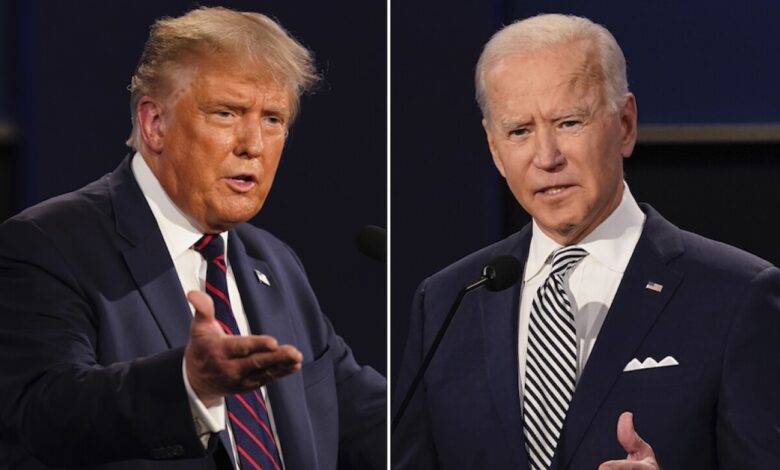What Are The Comparisons Between Trump vs Biden Economy?

Navigate the monetary panorama with insights into Trump vs Biden economy. Explore the contrasting monetary rules, affects, and destiny implications of each administration. Stay knowledgeable on the economic trajectory and apprehend the key elements shaping the economic landscape on this complete analysis.
People in America search for someone to blame when the economy falters. The White House is frequently singled out for criticism.
Introduction to Comparisons Between Trump vs Biden Economy
However, to what extent does the president truly deserve praise or criticism? The response will play a major role in the 2024 presidential contest, which has already begun and may turn into a confrontation between the present and former inhabitants of 1600 Pennsylvania Avenue. Given that both previous presidents Donald Trump and Joe Biden have emphasized their contrasting economic histories, Barron’s looked at how the economy performed in several areas throughout each of their administrations.
For both, the economic record is inconsistent. After eight years of steady expansion following the 2007–09 economic slump, outgoing President Barack Obama left behind a robust economy that Trump inherited.
During the study period, there was steady employment growth and low inflation. However, rather than being a direct result of any changes made by Trump, growth in the gross domestic product and job creation were essentially a continuation of trends that started in the Obama administration. Wages remained stagnant.
In his early years, Trump achieved one significant piece of legislation: a package of tax cuts for people and businesses that were enacted in 2017. The actions increased demand and investment in the stock market, but they also increased the amount of debt in the United States.
As the economy was still recuperating from the Covid pandemic shutdowns, Biden came into office, and the constant stream of stimulus funds that was approved under both his and Trump’s leadership contributed to a significant surge in expenditure. In addition to pushing prices higher and forcing the Federal Reserve to start quickly tightening monetary policy—actions that might precipitate a recession in the coming months—this also helped employment growth soar to record highs in each of the previous two years.
BUSINESS EXPANSION
During his 2016 presidential campaign, Trump made a promise to convey the U.S. Economic system falls back to 4% every year. But he only managed to fulfil that purpose in quarters, at some stage in the preliminary reopening and recuperation of the U.S. Economic system within the fourth zone of 2017 and the 0.33 zone of 2020.
Between the first quarters of 2017 and 2019, there was an average rise of 2.5% each quarter in real GDP (adjusted for inflation). Though it is well within the range of growth rates that Trump had promised and comparable to the conclusion of Obama’s second term, that is a healthy level for a sizable and varied economy that typically experiences growth of 2% to 3% annually.
In his first year in office, Biden oversaw rapid economic growth as government stimulus funds poured in to offset the economic impact of the epidemic. Growth reached a 7% annual pace in two of his first four quarters. But during his second year in power, inflation bit, and growth slowed down in the first half of 2022.
Nevertheless, in common, Biden has managed growth at a faster tempo than Trump. The maximum recent length for which records are to be had, from the primary quarter of 2021 to the first area of 2023, showed that monetary increase under the Biden administration averaged three.1% every sector.
STOCK MARKET ACTIVITY
Trump created an excessive precedence at the inventory marketplace, overseeing a 21.2% boom inside the SP 500 index from his first day in the workplace till the give up of May 2019, or nearly 2.Five years later. His 2017 tax cuts contributed to the favourable climate that became fostered via low unemployment rates and improved agency funding in addition to patron spending.
Over the same duration, the S and P 500 increased with the aid of eight.5% below Biden. Say it’s the tale of two markets: Although the benchmark S and P 500 fell 20% and the tech-heavy Nasdaq Composite about 33% in the final year as the Federal Reserve tightened financial coverage to govern skyrocketing inflation, stocks reached an all-time excessive at the start of 2022. The assumption that the Federal Reserve will soon stop raising hobby quotes and can perhaps decide to lower them later within the year contributed to the S and P 500’s nine.Three% upward push this year via May 31.
IMPLEMENTATION
The United States noticed a duration of surprisingly low inflation below the Trump administration, carrying away from the traditionally low degrees seen in some unspecified time in the future of Obama’s years in office. From the second one quarter of 2009 to the fourth region of 2016, inflation averaged 1.Four%. From the number one two years of the Trump control to the first quarter of 2019, inflation averaged 2.2%.
But the style of charge boom has become altered with the aid of the government’ response to the Covid epidemic, which struck the United States difficult in March 2020, and the beginning of the battle in Ukraine in February 2022. As transport lines have been disrupted by Russia’s invasion of Ukraine and the Trump and Biden administrations flooded the banking gadget with coins to offset Covid-related losses, inflation shot up to a 4-decade excessive and emerged as the number one financial issue of the Biden duration.
In an effort to slow economic increase, the Fed commenced trekking hobby rates in March 2022 after first viewing inflation as transient. However, inflation has examined harder to govern than predicted an extra year later. The patron charge index reading of four.Nine% in April of this year signified the ninth consecutive month in which the as soon as a 12 months pace of inflation has decreased, following a pinnacle of nine% in June 2022. However, month-to-month rises keep, and the non-public-consumption expenses charge index—the Fed’s favoured inflation gauge—stays far above the applicable monetary group’s 2% intention.
This inflation plagues the Biden management even now, specifically inside the form of high priced food. Even with a historically robust task market and splendid pay boom, persistently excessive prices have weakened Americans’ buying electricity and undermined purchaser self notion.
Rates of Interest
Throughout the first half of the Trump administration, the Federal Reserve gradually increased interest rates in an effort to return monetary policy to neutral after years of almost zero rates. For this strategy, the Fed has frequently come under fire from Trump, who claimed that higher rates were making it more difficult for the American economy to compete internationally. However, with inflation under control, the Fed kept raising rates until 2019, when worries about a global downturn and a recession prompted it to start loosening monetary policy.
Meanwhile, as the Fed has attempted to control inflation, Biden’s administration has witnessed some of the most severe monetary policy tightening in decades. Although this has slowed price inflation from its high, it has also increased the cost of buying a vehicle and a house, led to job losses in rate-sensitive industries, and alarmed investors who are anticipating a recession.
Governing Debt
The government debt ballooned under both presidents, mostly as a result of Trump’s tax cuts and Biden’s Covid assistance initiatives.
Towards the conclusion of the president’s tenure, the Trump administration also implemented significant Covid-aid spending, which increased the national debt; nonetheless, both parties mostly approved of these expenditures.
Long-term trends and the expansion of programs like Medicare, Medicaid, and Social Security—which are getting more expensive as the American population ages—are largely to blame for the recent increase in the size of the federal deficit. In a report published in 2021, Charles Blahous, a senior research strategist at George Mason University’s Mercatus Center, calculated that the policies put in place when such programs were implemented in the late 1960s and early 1970s account for around 60% of the overall long-term budget imbalance.
According to Blahous’ estimation, Trump was accountable for 19.1% of the federal debt in 2021, whereas Biden was responsible for 18.5%.
THE MARKET FOR JOB
At the beginning of his administration, Trump presided over robust employment growth, with the labour market adding 180,000 jobs each month on average. That was a healthy level for an economy that had already recovered from the recession brought on by the 2008–2009 financial crisis almost ten years earlier. Furthermore, it was far higher than the 100,000 jobs a month that experts predict are required to keep up with population growth.
Since taking office, Biden has witnessed a rise in the labour market, with an average of 470,000 new jobs being created each month. True, he took over a post-Covid rebound in a labour market with much capacity to expand, but even as concerns about a recession have grown, job growth has continuously outperformed forecasts.
The greatest two years of employment creation in American history occurred during Biden’s first two years in office. Since the Covid-19 recession, the size of the labour market as a whole has more than recovered.
THE HOUSE MARKET
According to the U.S. Census Bureau, home prices in the United States have been rising for almost thirty years. By the end of 2022, the median selling price had more than tripled from $126,000 in 1992 to $479,500. Although the Trump administration celebrated increasing property values, the first two years of the Biden administration had some of the sharpest rises in median house selling prices in the previous 30 years as the need for greater room clashed with a general housing scarcity after the Covid-19.
While rising property values are wonderful for homeowners, they present difficulties for prospective purchasers. According to research, American consumers’ financial security is enhanced by homeownership. This can be threatened by rising property prices. Nevertheless, the market has relaxed. In March, annual increase in home prices fell to 0.7%, the lowest level in almost a decade, as reported by the S&P CoreLogic Case-Shiller National Composite Index. According to housing specialists, the present slump in the housing market is likely to last until 2023 and maybe even into 2024. Affordability should be enhanced by declining prices, especially when the Fed stops raising interest rates and mortgage rates start to decline.
Conclusion:
As the chapters of the Trump vs. The Biden economy spread, it will become clear that each management has left an indelible mark on the nation’s economic trajectory. Whether analyzing tax guidelines, stimulus measures, or average financial philosophies, the nuances of those techniques shape the monetary landscape for years yet to come. As we conclude this analysis, the continuing talk surrounding monetary rules stays primarily to know-how the complexities of a kingdom in regular economic evolution.



